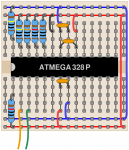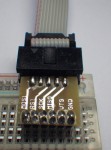After the first two parts of this series ATmega328P – measuring its own supply voltage ATmega328P – measuring its own supply voltage II where I investigated the possibility of the Atmel ATmega series microcontrollers to select the internal bandgap voltage VBG as input for the analog-to-digital converter. Using the analog supply voltage AVcc as reference… Continue reading ATmega328P – measuring its own supply voltage III
Category: Computers
ATmega328P – measuring its own supply voltage II
Here is a brief follow up from yesterday’s post on the internal reference voltage VBG of the ATmega328P. I wrote a small test program where I wait for a variable delay time after switching the input multiplexer of the analog-to-digital converter to the internal bandgap reference voltage VBG. Using the AVcc of as the conversion… Continue reading ATmega328P – measuring its own supply voltage II
ATmega328P – measuring its own supply voltage
The trick is not new, it is utilized in the AVR transistor tester which you can buy for quite cheap money from China, and it has been discussed in internet forums for almost 10 years (see below for some links). The Atmel AVR microcontrollers feature an analog to digital converter (ADC) equipped with a multichannel… Continue reading ATmega328P – measuring its own supply voltage
XeTeX and your math is bitmapped?
I have now been using XeLaTex exclusively for quite a while for all my LaTeX work, which essentially means for everything: lecture notes, lecture slides, lab instructions, letters, reports,… For some shorter time the symbols in my equations would show up ok on screen but a bit blurry on printouts. I was looking for the… Continue reading XeTeX and your math is bitmapped?
QuizClash
Sorry, this entry is only available in Deutsch.
Brave New World
Today my employer, Uppsala University, will migrate our email system from an open-source and Unix based one to Exchange Server. At the same time we are all encouraged to migrate ourselves to using Exchange/Outlook for the sake of the benefits. Well, I will not, ever… Some working group in the administration has decided that it… Continue reading Brave New World
AVR ISP breadboard adapter
Breadboards are great! I mean the solderless breadboard type which you can get everywhere now for almost no money. I use them all the time to prototype electronics circuits and have been forcing my students to do the same. Most of my current projects also involve AVR microcontrollers which support an in-system programming. For this… Continue reading AVR ISP breadboard adapter
Upgrading a RAID-1 Ubuntu-server
It’s almost 4 years now since I installed my server and I decided it was time for some new (bigger) harddisks. I wrote about my server earlier in my blog, but here is a short summary about its current state before the upgrade: processor AMD Athlon (Barton) 1.3 GHz(?) mainboard Zenith … memory 512 MByte… Continue reading Upgrading a RAID-1 Ubuntu-server
Merry Christmas!
Repairing a Samsung Syncmaster 913TM
I recently got hold of another broken Samsung monitor. This time it is a Syncmaster 913TM which is characterized by its swiveling stand, which allows the screen to be rotated by 90 degrees. I would not call this “portrait” as opposed to landscape, because of the screen’s almost square aspect ratio of 5:4. Connecting power… Continue reading Repairing a Samsung Syncmaster 913TM








